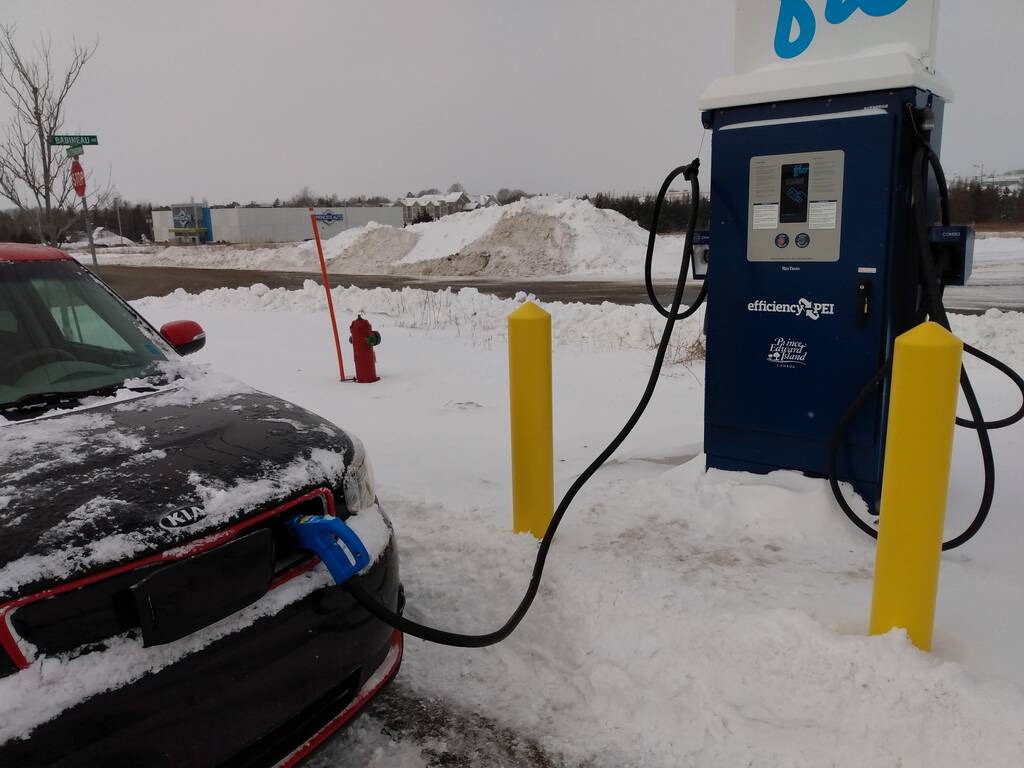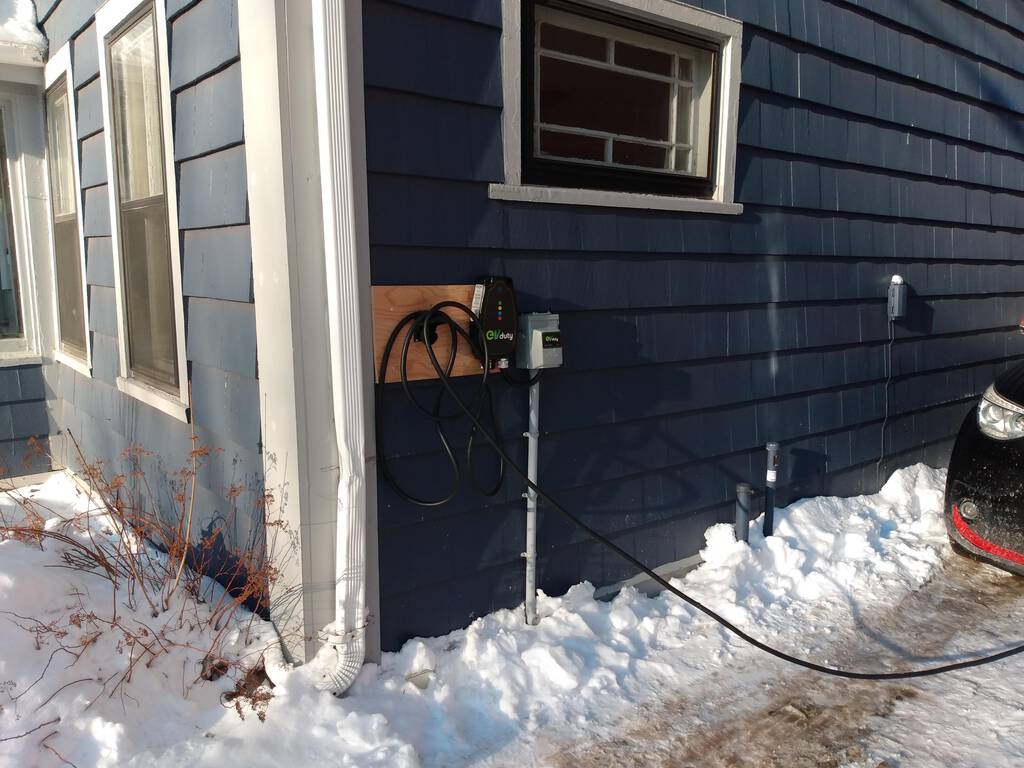For the first month we had our Kia Soul EV electric vehicle, we charged it from a regular 120 volt outlet at the end of our driveway, an outlet originally installed to power the heating cables to keep ice dams from forming on our roof. We used the portable charger that came with the car. While this was convenient, inasmuch as it didn’t require us to install anything, charging the car this way is very slow: at least overnight to go from 50% to 100%.
When we needed faster charging we used “level 2” chargers at places like Access PEI and Efficiency PEI; these 240 volt chargers charge much more quickly, and can go from 50% to 100% in just a few hours.
On January 18, 2020 a new option became available, a high speed “level 3” charger off the Canadian Tire parking lot in Charlottetown. This charger can take our Kia Soul from empty to 80% in less than half an hour.

This faster charging comes at a hefty price: because only Maritime Electric can sell electricity, the use of this charger is billed by time, not energy, at a rate of $20 per hour.
The first time we used it we paid $14.84 for 8.06 kWH of electricity (a whopping $1.84 per kWh, or about 13x what we pay for electricity at home); four days later we paid $7.02 for 10.5 kWh (still an almost 5x premium over retail electricity). What determines the rate of charge, and thus the cost per kWh, I do not know.
A couple of weeks ago, our electrician came to install the wiring–a 240 volt “dryer” outlet in a weatherproof box–for our own EVDuty-brand charger, which we received as part of the purchase of the Soul from Pure EV in December. And finally, late last week, I got around to mounting the charger itself on the side of the house:

There are several benefits having a level 2 charger at home:
- The faster charging time means that I’ll rarely, if ever, get caught without a way to quickly charge the car.
- I can set the Kia Soul EV up to automatically charge to 80% or 100% every night if I like, as long as it’s plugged in, and I can also set it to warm and defrost the vehicle, from the mains electricity not the battery, so that it’s ready to drive at a time I set.
- The charger is there for others to use; outside of the flaky charger in the parking garage of the Delta Prince Edward, this makes it the first EV charger in downtown Charlottetown. And while I can’t support full-on public charging–I need to be able to get my own car in and out!–I’m happy to offer those that need it a “top up.”
So far I’m happy with the EVDuty charger: it does what it says on the tin, and, after I paid a $100 upgrade fee online, I have real time access to the charger via an app on my Android phone.
I’ll report back once I’ve had more experience with the charger.
 I am
I am
Comments
I am wondering how this will
I am wondering how this will impact your monthly home electricity expense? Using a dryer or the kiln- same voltage -for a few hours a week results in a noticeably higher bill. Curious.
That's interesting about the
That's interesting about the cost difference at the Flo charger, Peter. They also have set one up at the Canadian Tire in Summerside, but it wasn't online last time I checked. Did you notice the words "Rio Tinto" above the efficiencyPEI logo? That seemed weird to me.
Heating cables in the roof!
Heating cables in the roof! Living in a region with few frost days and rarely any staying snow the casual mention of this everyday thing describes a different reality.
Peter, Have you considered
Peter, Have you considered further "greening" your home energy mix with a green energy retailer such as Bullfrogpower? While Maritime Electric's mix is already greener than in other areas, there is still a considerable portion of fossil fuel generation included, which is used to charge your electric vehicle. I've "greened" my home, business and cars for a number of years and even tough it is only offsetting fossil generation instead of truly preventing it in the first place, there aren't many other options in PEI yet, and this is at least a small step and message in the right direction.
Bullfrog is a marketing
Bullfrog is a marketing gimmick in areas where, realistically, the investments will not actually reduce fossil fuel usage such as PEI. PEI's electrical carbon footprint comes from purchasing from NB, and Bullfrog doesn't have any substantive investment in generation projects in NB and is instead purchasing on your behalf from sources that PEI already sources for its energy mix. You're just double buying the same thing.
You would be better served taking the $25/month and investing it in energy reduction projects like replacing appliances, switching to LEDs, or implementing an energy audit. True energy movement comes from reduction, not offsetting.
The benefit of having an EV
The benefit of having an EV charger with an API, and open data about the nature of the load-generation mix, is that I can make intelligent carbon-reducing choices–or have my robots make them for me–about when to charge and for how long.
Peter, I think what happened
Peter, I think what happened here is that you tried to fast charge an already charged battery, or the battery was too cold to be fast charged. Otherwise I don't know why your car would consume only 8.06 kWH in ~45 minutes ($14.84/20 * 60 min). Anyone who truly needs to fast charge would be doing so at at least 35kW, ideally between 40-50kW. Anything under 10kW and it's a real waste of the infrastructure - you may as well be Level 2 charging (@ up to 7.2kW).
Infrastructure has fixed costs. Maintenance is a function of sessions, hours used, and power delivered. Yes it sucks for your situation, but chances are you didn't need the charge to begin with.
$20/hr is a fair price for these types of stations in PEI, given the retail price of electricity.
Add new comment